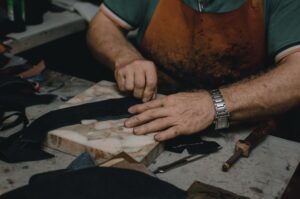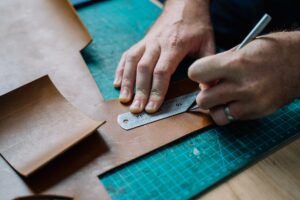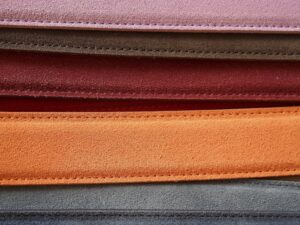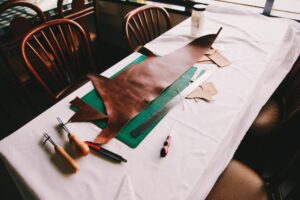
Cutting leather can be a challenging task, especially if you are not familiar with the proper tools and techniques. Whether you are a beginner looking to cut leather for the first time or an experienced leatherworker looking to improve your skills, it is important to have the right tools on hand. In this article, we will explore some of the most commonly used tools for cutting leather, including knives, scissors, and rotary cutters, and discuss their features and capabilities.
Best Tools for Cutting Leather
One of the most common tools used for cutting leather is the knife. Knives come in a variety of sizes and shapes, and are designed to slice through leather with precision and control. The type of knife you choose will depend on the task at hand, and there are several different types of knives that can be used for cutting leather, including utility knives, box cutters, and scalpels.
Utility Knife
Utility knives are a type of knife that is commonly used for cutting leather. They have a retractable blade that can be extended and locked in place, and are available in a range of sizes. Utility knives are versatile and can be used for a variety of tasks, such as cutting straight lines, creating intricate shapes, or trimming away excess material. They are often used by leatherworkers to cut leather for projects such as belts, bags, and wallets.
Box Cutters
Box cutters are another type of knife that can be used for cutting leather. They have a fixed blade that is designed for cutting cardboard, but can also be used to cut leather. Box cutters are lightweight and easy to handle, and are often used for tasks such as cutting straight lines or trimming away excess material.
Scalpel
Scalpels are a type of knife that is often used for more precise cutting tasks. They have a very thin, sharp blade that is designed for making precise cuts, and are often used by leatherworkers for tasks such as cutting intricate shapes or creating detailed designs. Scalpels can be more difficult to control than other types of knives, so they may not be the best choice for beginners.
Scissors and Shears
In addition to knives, another tool that is commonly used for cutting leather is the scissors. Scissors are a versatile tool that can be used for a variety of tasks, and there are several different types of scissors that are suitable for cutting leather.
Shears are a type of scissors that are designed for cutting large pieces of material, and are often used for cutting leather. They have long, curved blades and a comfortable handle, and are capable of cutting through thick leather with ease. Shears are a good choice for tasks such as cutting large pieces of leather or trimming away excess material.
Embroidery scissors are a type of scissors that are designed for cutting small, precise shapes, and are often used for tasks such as cutting intricate designs or trimming away excess material. They have sharp, pointed blades and are capable of making precise cuts, but may not be suitable for cutting thicker leather.
Rotary Cutters
Rotary cutters are another tool that can be used for cutting leather. Rotary cutters are circular blades that are mounted on a handle and can be used to cut through material in a straight line. They are often used for tasks such as cutting long, straight lines or creating precise shapes, and are a popular choice among quilters and other fabric workers.
How to Choose the Right Tool: 7 Factors to Consider
Before choosing a tool here are a few things to consider.
1. Leather Thickness
When selecting a tool for cutting leather, it is important to consider the thickness and type of leather you will be working with, as well as the size and shape of the cuts you need to make. For example, if you are working with thick leather and need to make long, straight cuts, a pair of shears or a rotary cutter may be the best choice. If you are working with fine, delicate leather and need to make precise, intricate cuts, a pair of embroidery scissors or a scalpel may be more suitable.
2. Blade Type
Different tools have different types of blades, and the type of blade you choose will depend on the task at hand. For example, straight blades are generally best for making straight cuts, while serrated blades are better for cutting through thicker materials. Some tools, such as rotary cutters, have interchangeable blades, which can be useful if you need to switch between different blade types.
3. Blade Length
The length of the blade can also be an important factor to consider when selecting a cutting tool. Longer blades are generally better for cutting through thicker materials or making longer cuts, while shorter blades are better for making precise cuts or working in tight spaces.
4. Blade Material
The material of the blade can also be important, as it can affect the durability and sharpness of the tool. Blades made of high carbon steel are generally more durable and hold their edge longer, while blades made of stainless steel are less prone to rust but may not be as sharp.
5. Comfort
When cutting leather, you will likely be using the tool for an extended period of time, so it is important to choose a tool that is comfortable to hold and use. Look for tools with ergonomic handles that fit comfortably in your hand, and consider the weight and balance of the tool as well.
6. Safety Features
Some cutting tools, such as utility knives and rotary cutters, have safety features that can help prevent accidents. For example, utility knives may have a blade lock or a blade retraction mechanism to prevent the blade from accidentally extending, and rotary cutters may have a safety lock or a blade guard to prevent the blade from accidentally cutting you or the material.
7. Quality
In addition to the size and type of tool, it is also important to consider the overall quality of the tool. Higher quality tools are often made of higher quality materials and are more precise and durable. While they may cost more upfront, they can save you time and frustration in the long run, as they are less likely to break or wear out quickly.
By considering these factors, you can select a tool that is well-suited to your needs and will allow you to cut leather with precision and control. Remember to always use caution when cutting leather, as the blades of these tools can be sharp and can cause injury if not used properly. Always follow the manufacturer’s instructions and use proper safety equipment, such as gloves and goggles, to protect yourself while working with these tools.
A Word of Caution
It is also important to keep your tools well-maintained, as dull or damaged tools can be difficult to use and may produce poor results. For example, you should keep your knives sharp by regularly honing or sharpening the blades, and you should clean and lubricate your scissors to keep them in good working order.
By considering these factors when selecting a tool for cutting leather, you can ensure that you have the right tool for the job, which will result in better, more professional-looking results in your leather projects. With the right tools and a little practice, you will be able to cut leather with precision and control, enabling you to create a wide range of beautiful and functional leather projects.






